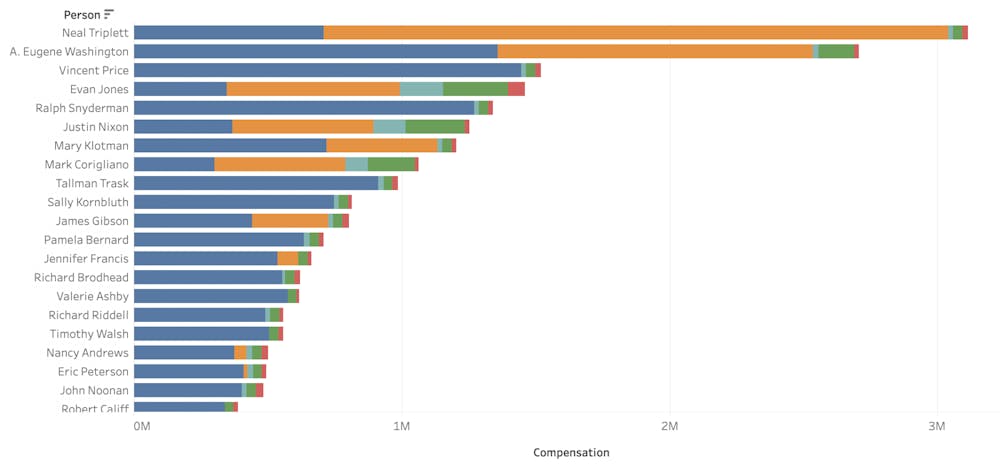The price for President Vincent Price was right—and it was over $1 million in the 2019 fiscal year, as revealed by recently released tax forms.
According to 990 tax form data from 2019, 12 Duke employees earned over $1 million. They range from members of the University administration, including Price, to personnel in the athletics department.
Academic administrators
Price maintained his position from 2018 as the third-highest paid non-athletics employee. He also ranked sixth on the list of Duke’s highest compensated employees, according to the University’s tax forms for the fiscal year from July 2019 to June 2020.
Neal Triplett, president and CEO of the Duke University Management Company (DUMAC) and Chancellor of Health Affairs A. Eugene Washington are the two non-athletics employees that rank above Price.
Triplett earned just over $3.1 million in 2019, a 6% pay decrease compared to 2018. Washington, who earned just over $2.7 million, also made less than he did in 2018, with a 2% decrease in his total compensation.
Of note, Triplett and Washington each earned significant bonuses which comprised a large portion of their total compensation. Over half of Triplett’s total compensation came from bonuses and upwards of 40% of Washington’s total compensation came from his bonus.
Price had a 9% increase in total compensation, which came out to be just over $1.5 million.
However, Price did not receive any bonuses in 2019, which was also the case in 2018. In 2017, Price received $350,000 in bonus compensation.
Most other current key non-athletic Duke employees also received raises. Of the seven personnel who didn’t receive a raise, only three were current employees.
Bonuses are given to a limited number of executives within the University, Duke Health and DUMAC. DUMAC is the body responsible for managing the University’s endowment, which recently grew by over 50% and the Duke Endowment.
On the 990 tax form, total compensation is calculated from base compensation, bonus and incentive compensation, other reportable compensation, retirement and other deferred compensation and nontaxable benefits.
Private Capital Team Head Mark Corigliano, who is also a DUMAC member, was the only addition to the million dollar club in 2019. In 2018, Corigliano earned just over $750,000. He had the highest percent increase in total compensation out of non-athletics employees at 41%, bringing his total compensation over $1.06 million. The other two investment managers listed on the form received a pay increase of more than 10% each as well.
Former President Richard Brodhead and Nancy Andrews, former dean of the School of Medicine each received a compensation decrease of 43%, the largest decrease out of anyone listed on the tax form.
Athletic administrators
All four listed athletics personnel made above $1 million, as was the case in 2018. Men’s basketball head coach Mike Krzyzewski netted more than any other Duke employee by far, with his total compensation listed at over $7.3 million.
The listed athletics personnel also all received an increase in total compensation compared to the previous year. Former athletic director Kevin White received the largest increase of any listed Duke employee at 50%.
Interactive graphics made by Adway Wadekar.
Get The Chronicle straight to your inbox
Signup for our weekly newsletter. Cancel at any time.

Adway S. Wadekar is a Trinity junior and former news editor of The Chronicle's 119th volume.

